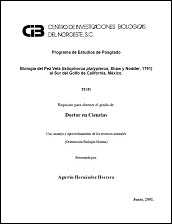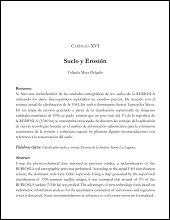Geminivirus en tomate en Baja California Sur: identificación, caracterización y epidemiología
Resumen
Al estudiar la etiología de la enfermedad del “enchinado foliar” en el cultivo del tomate en Baja California Sur (BCS), se detectaron tres geminivirus no descritos y uno previamente reportado en México. Las pruebas de DAS-ELISA, la separación electroforética de la forma replicativa (FR) del ADN viral, los análisis de hibridación molecular y la amplificación por PCR nos indicaron que estos geminivirus tienen dos moléculas de ADN de cadena sencilla (bipartitas) y que pertenecen al género Begomovirus. Las reacciones de PCR fueron realizadas con iniciadores genéricos y específicos que amplifican los genes: AV1 (CP), AC1 (Rep), AC2 (TraP), AC3 (REn), incluyendo la región intergénica (RI). Los productos de PCR clonados y secuenciados se compararon por alineamientos locales (BLAST) usando como referencia los geminivirus de la base de datos del NCBI (GenBank). Las secuencias que produjeron las más altas identidades fueron comparadas por alineaciones múltiples en el programa MegAlign (DNASTAR) basados en la secuencia nucleotídica (nt) completa del componente A (ADN-A) o en un fragmento (RI-1.1 kb) que incluye la región amino terminal de Rep y CP, así como la RI. En el área de La Paz se detectó un geminivirus con un 73.8 % (nt) de identidad (ADN-A) con el virus del enrollamiento severo del tomate (Tomato severe leaf curl virus-ToSLCV) y un 83.8 % de identidad (RI-1.1 kb) con un geminivirus parcialmente caracterizado, tentativamente nombrado virus del jaspeado ligero del tomate (Tomato mild mottle virus, ToMMoV). En la misma región se encontró un geminivirus con un 98 % de identidad (RI-1.1 kb) con la variante de Tamaulipas del virus del mosaico dorado del chile (Pepper golden mosaic virus-PepGMV-[Tam]). En la región de el Calandrio se detectó un geminivirus con un 82.8 % de identidad (RI-1.1 kb) con el ToSLCV. Finalmente, en el Carrizal se detectó un geminivirus con la identidad más alta (90.2%) con el virus aislado de La Paz. Basados en los análisis de identidad, filogenia y estructura de iterones estos geminivirus fueron designados como: chino del tomate de La Paz (Tomato chino de La Paz virus-ToChLPV [AY339618]), chino del tomate de el Calandrio (Tomato chino Calandrio virus-TChCV [AY336088]) y chino del tomate de Baja California Sur (Tomato chino Baja California Sur virus-ToChBCSV [AY339619]) [...] In the aim to study the etiology of the tomato “chino” leaf curl disease in Baja California Sur (BCS) tomato crops, three new geminiviruses and one previously reported in Mexico were detected. DAS-ELISA, electrophoresis motility of DNA replicative form (RF), DNA hybridization and PCR assays, as well as, sequences analysis indicated that these geminivirus have two single-stranded DNA molecules (bipartite) and belong to the genus Begomovirus. PCR reactions were realized using specific and degenerate primers that target the AV1 (CP), AC1 (Rep), AC2 (Trap), AC3 (REn) genes, including the intergenic region (IR). Amplicons were cloned and sequenced and compared by local alignment (BLAST) to other geminiviruses and of the NCBI data base (GenBank). The nucleotide (nt) sequences with the highest scores were analyzed by multiple alignments using MegAlign (DNASTAR), based on the identities percentages of the complete DNA-A sequence, either in the fragment (IR-1.1 kb) that includes the amino termini region of Rep and CP as well as the IR. A geminivirus sharing a 73.8% nt identity (DNA-A) to Tomato severe leaf curl virus (ToSLCV) and 83.8% (IR-1.1 kb) to the partially characterized Tomato mild mottle virus (ToMMoV) was detected in La Paz. In the same region, a geminivirus sharing 98% (IR-1.1 kb) nt identity to Pepper golden mosaic virus-PepGMV Tamaulipas strain was found. An isolate from the Calandrio area shared 82.8% nt sequence identity (IR-1.1 kb) to ToSLCV. Finally, the geminivirus found in the Carrizal shared the highest nt identity (90.2%) to the La Paz isolate. Based on the nt identity, phylogeny and structural analysis of iterons these geminivirus were named: Tomato chino La Paz virus-ToChLPV (AY339618), Tomato chino Calandrio virus-TChCV (AY336088), and Tomato chino Baja California Sur virus-ToChBCSV (AY339619) [...]
Colecciones
Ítems relacionados
Mostrando ítems relacionados por Título, autor o materia.
-
PROMOCIÓN DEL PERIFITON PARA EL CULTIVO DE CAMARÓN BLANCO: HACIA UNA ACUICULTURA ECOLÓGICA
DOMENICO VOLTOLINA LOBINA; JUAN MANUEL AUDELO NARANJO; MARIA DEL ROSARIO PACHECO MARGES -
Suelo y Erosión
YOLANDA LOURDES MAYA DELGADO


